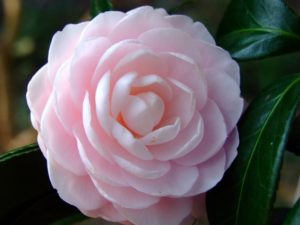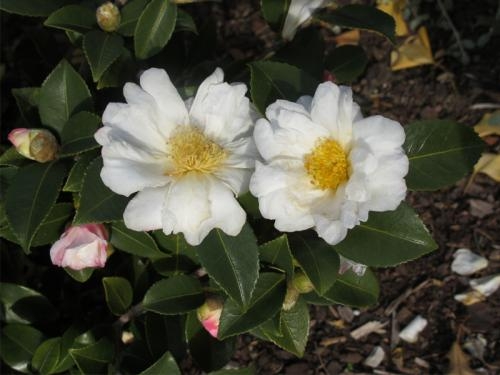
By Heather N. Kolich, County Extension Coordinator, UGA Extension Forsyth County, October 2022
Fall has arrived signaling the end flowering for southern landscape staples like roses, gardenias, and azaleas. But fall doesn’t have to mean an end of flowering shrubs altogether. Cold-hardy camellias offer
fragrant blooms from September to March in USDA hardiness zones 7 and 6b. Camellias – the winter rose
Years ago, I had the opportunity to tour Massey Lane Gardens, headquarters for the American Camellia Society, located in Fort Valley, Georgia. Bundled up against a chilly November wind, I wandered along brick walkways through a forest of blooming camellias that towered tree-like in the nine-acre camellia garden. I was enchanted with these winter-blooming, evergreen shrubs.
Although I was warned that my upper–piedmont planting grounds might be too cold for camellias to survive, I came home with two Camellia japonica cultivars:
Professor Sargent, with peony–like red blooms; and Nuccio’s Pearl, with pale pink outer petals cupping a stunning fully double white flower. The beauty of camellias is more than the bloom. Like azaleas and rhododendrons, camellias are shade–tolerant shrubs. They are evergreen, with glossy, dark–green leaves and a variety of forms and sizes. Some grow upright while others are spreading. Camellia hiemalis are compact plants with a slow growth rate, C. japonica can reach 15 feet tall and eight feet wide, and some C. sasanqua may grow to a 10–foot column. The caffeine–containing young leaves of C. sinensis are the source of tea, and the seeds of C. oleifera contain oil that is used for cooking and manufacturing cosmetic products. As added bonuses, camellia flowers are fragrant, and the shrubs are long–lived.
My experiment with camellias in North Georgia was partially successful. The Nuccio’s Pearl was definitely out of its hardiness zone of 8–9, but Professor Sargent, with a cold tolerance of 10 degrees Fahrenheit, did well. It was still growing and blooming when I sold that house 10 years later, but it was much smaller than its potential mature size. Cold–hardy camellias Since my visit to Massey Lane Gardens, camellia breeders have hybridized and brought to market several camellia cultivars that are cold–hardy up to USDA zone 6b. It was a long process, beginning with the collection of C. japonica seeds from islands along the northwestern coast of Korea in 1984, where camellias are exposed to extreme temperatures from persistent cold winter winds. Over several years, plants grown from the seeds in field trials at the
Morris Arboretum in Philadelphia, PA were evaluated and whittled down from 730 seedlings to 25 highly–rated plants selected for planting into the public gardens in 1999. After a few more winters, 15 received an “A” rating. Plants grown from cuttings of these top–rated, cold–hardy camellias were shared with other public gardens in northeastern states. Along with these field trials, plant breeders Dr. William Ackerman of the National Arboretum in Washington D.C. and Dr. Clifford Parks of the University of North Carolina in Chapel Hill began camellia breeding programs with the goal of incorporating the cold–hardiness of common camellias into attractive landscape cultivars. These cold-hardy camellia hybrids are now commercially available as both fall and spring blooming selections, with names like ‘Winter’s Rose’ (fall, pink, 3’x3’ mature size), ‘Polar Ice’ (fall, white, 10’ mature size), ‘April Rose’ (spring, deep pink. 5’-8’),
and ‘Korean Fire’ (spring, red, 10’-15’).

Camellia tours
Blooming season for camellias begins in October (also a great time to plant them), and Georgia is home to 30 public gardens that feature camellias. If you need a little more convincing to try planting a camellia
or three in your landscape, consider taking a drive along the Georgia Camellia Trail, one of the agritourism trails on Explore Georgia. From Berry College in Rome to the Coastal Georgia Botanical Gardens in Savannah, the Georgia Camellia Trail meanders through the heartland of the U.S. “camellia belt,” showcasing extensive collections of camellias both beautiful and useful.